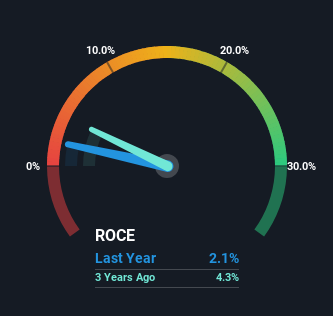- Malaysia
- /
- Consumer Durables
- /
- KLSE:FIHB
Some Investors May Be Worried About Federal International Holdings Berhad's (KLSE:FIHB) Returns On Capital

If we want to find a stock that could multiply over the long term, what are the underlying trends we should look for? Amongst other things, we'll want to see two things; firstly, a growing return on capital employed (ROCE) and secondly, an expansion in the company's amount of capital employed. Put simply, these types of businesses are compounding machines, meaning they are continually reinvesting their earnings at ever-higher rates of return. Although, when we looked at Federal International Holdings Berhad (KLSE:FIHB), it didn't seem to tick all of these boxes.
What Is Return On Capital Employed (ROCE)?
If you haven't worked with ROCE before, it measures the 'return' (pre-tax profit) a company generates from capital employed in its business. Analysts use this formula to calculate it for Federal International Holdings Berhad:
Return on Capital Employed = Earnings Before Interest and Tax (EBIT) ÷ (Total Assets - Current Liabilities)
0.021 = RM3.0m ÷ (RM211m - RM64m) (Based on the trailing twelve months to December 2023).
Thus, Federal International Holdings Berhad has an ROCE of 2.1%. Ultimately, that's a low return and it under-performs the Consumer Durables industry average of 10%.
Check out our latest analysis for Federal International Holdings Berhad

While the past is not representative of the future, it can be helpful to know how a company has performed historically, which is why we have this chart above. If you're interested in investigating Federal International Holdings Berhad's past further, check out this free graph covering Federal International Holdings Berhad's past earnings, revenue and cash flow.
What Can We Tell From Federal International Holdings Berhad's ROCE Trend?
On the surface, the trend of ROCE at Federal International Holdings Berhad doesn't inspire confidence. Around five years ago the returns on capital were 9.5%, but since then they've fallen to 2.1%. And considering revenue has dropped while employing more capital, we'd be cautious. If this were to continue, you might be looking at a company that is trying to reinvest for growth but is actually losing market share since sales haven't increased.
What We Can Learn From Federal International Holdings Berhad's ROCE
From the above analysis, we find it rather worrisome that returns on capital and sales for Federal International Holdings Berhad have fallen, meanwhile the business is employing more capital than it was five years ago. In spite of that, the stock has delivered a 26% return to shareholders who held over the last five years. Regardless, we don't like the trends as they are and if they persist, we think you might find better investments elsewhere.
On a final note, we've found 2 warning signs for Federal International Holdings Berhad that we think you should be aware of.
While Federal International Holdings Berhad isn't earning the highest return, check out this free list of companies that are earning high returns on equity with solid balance sheets.
New: AI Stock Screener & Alerts
Our new AI Stock Screener scans the market every day to uncover opportunities.
• Dividend Powerhouses (3%+ Yield)
• Undervalued Small Caps with Insider Buying
• High growth Tech and AI Companies
Or build your own from over 50 metrics.
Have feedback on this article? Concerned about the content? Get in touch with us directly. Alternatively, email editorial-team (at) simplywallst.com.
This article by Simply Wall St is general in nature. We provide commentary based on historical data and analyst forecasts only using an unbiased methodology and our articles are not intended to be financial advice. It does not constitute a recommendation to buy or sell any stock, and does not take account of your objectives, or your financial situation. We aim to bring you long-term focused analysis driven by fundamental data. Note that our analysis may not factor in the latest price-sensitive company announcements or qualitative material. Simply Wall St has no position in any stocks mentioned.
About KLSE:FIHB
Federal International Holdings Berhad
An investment holding company, engages in the construction and interior fit out businesses in Malaysia.
Good value with adequate balance sheet.
Market Insights
Community Narratives




